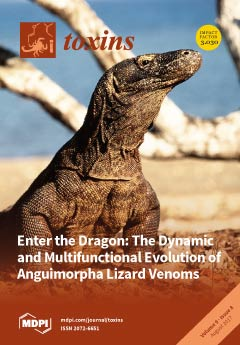Bothrops lanceolatus, commonly named ‘Fer-de-Lance’, is an endemic snake of the French Caribbean Island of Martinique. Envenomations by
B. lanceolatus present clinical aspects characterized by systemic thrombotic syndrome and important local inflammation, involving edema and pain but limited hemorrhage. To investigate mechanisms
[...] Read more.
Bothrops lanceolatus, commonly named ‘Fer-de-Lance’, is an endemic snake of the French Caribbean Island of Martinique. Envenomations by
B. lanceolatus present clinical aspects characterized by systemic thrombotic syndrome and important local inflammation, involving edema and pain but limited hemorrhage. To investigate mechanisms of venom-induced inflammation,
B. lanceolatus venom was characterized, its cross-reactivity with bothropic antivenom explored, its cytotoxicity on human keratinocytes and vascular cells, and the production of cytokines and chemokines were analyzed. We used electrophoretic separation, zymography, colorimetric or fluorimetric enzymatic assays, and immunochemical assays. Therapeutic South American bothropic antivenom cross-reacted with
B. lanceolatus venom and completely or partially abolished its PLA2, hyaluronidase, and proteolytic activities, as well as its cytotoxicity for keratinocytes. The substrate specificity of
B. lanceolatus venom proteases was emphasized.
B. lanceolatus venom cytotoxicity was compared to the
B. jararaca venom. Both venoms were highly cytotoxic for keratinocytes (HaCaT), whereas
B. lanceolatus venom showed particularly low toxicity for endothelial cells (EAhy926). Patterns of cytokine and chemokine production by cells exposed to the venoms were highly pro-inflammatory. Thus, the results presented here show that
B. lanceolatus venom toxins share important antigenic similarities with South American
Bothrops species toxins, although their proteases have acquired particular substrate specificity. Moreover, the venom displays important cytotoxic and pro-inflammatory action on human cell types such as keratinocytes and endothelial cells, which are important players in the local and systemic compartments affected by the envenomation.
Full article






